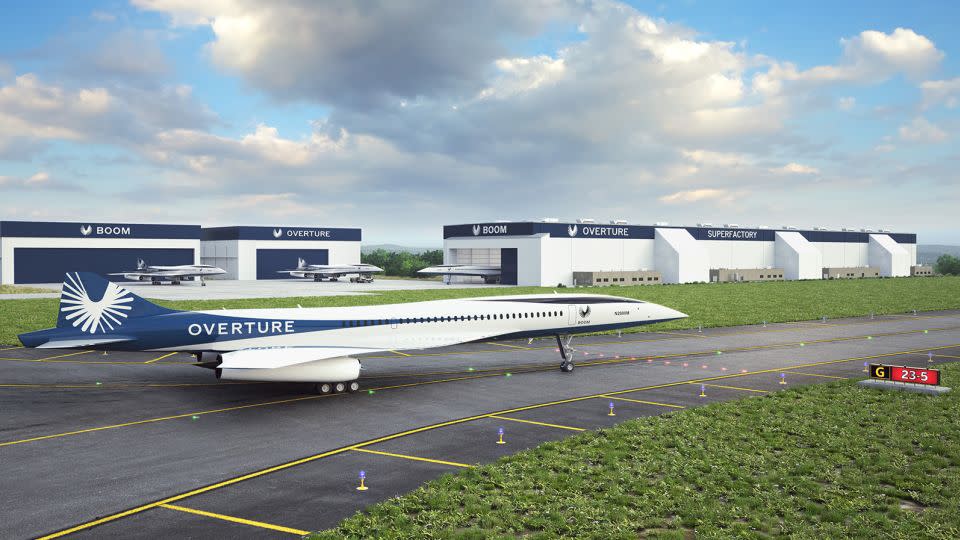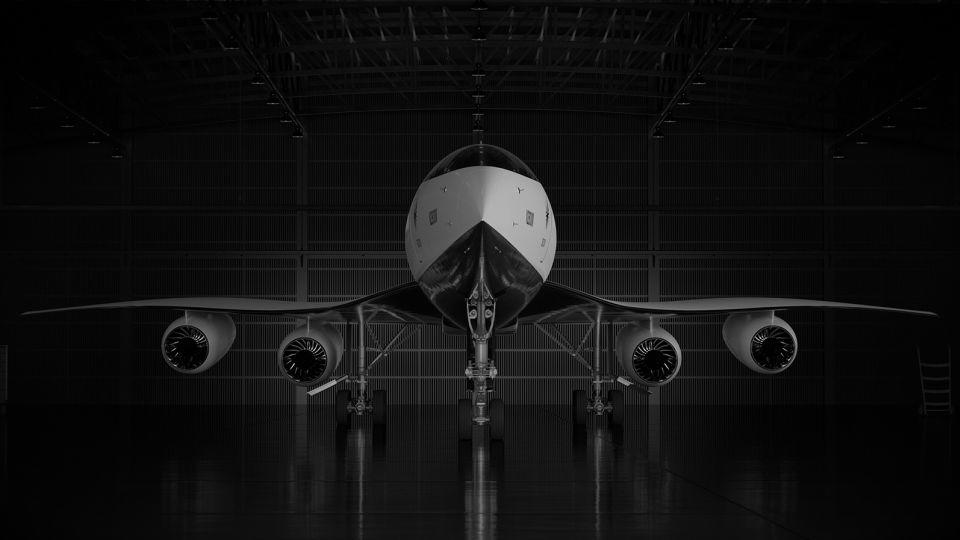Boom wants supersonic plane travel for everyone — but can it deliver?
There’s no shortage of ambition in commercial aviation — we wouldn’t have heavier-than-air flight without dreamers, after all — but Boom Supersonic is in its own category when it comes to setting the bar high.
The Colorado-based company aims to reintroduce commercial supersonic flight, which has been on hiatus since Concorde was retired in 2003. But unlike Concorde, an elitist engineering marvel that only a handful of airlines ever operated, Boom hopes its supersonic aircraft — called Overture — will democratize this type of travel, making it accessible to the masses.
“We’ve set out with a really big, audacious goal of creating the first supersonic airliner that tens of millions of people can fly on,” Blake Scholl, Boom Supersonic’s founder and CEO, tells CNN. “Supersonic travel, in my view, is about bringing the world closer together. Our ultimate vision is supersonic flight for every passenger on every route.”
Boom plans to introduce Overture to commercial service by 2029, and while that might prove challenging, the company has recently unveiled a series of new details about its technology and partners that, Scholl believes, bring that dream a few steps closer to reality.
A complex process
Overture is designed to carry between 64 and 80 passengers, at a speed of Mach 1.7 and an altitude of 60,000 feet. That’s twice the speed and 50% more altitude than leading widebody aircraft like the Boeing 787 or the Airbus A350 — as a result, Overture would travel between London and New York in about three and a half hours, cutting journey time in half.
The plane doesn’t exist yet — the first one is expected to roll out of the factory as early as 2026 — but three airlines have already placed orders for it. They are United Airlines, American Airlines and Japan Airlines, with a total of 130 orders, of which 35 come with non-refundable deposits, and 95 are pre-orders, meaning that money hasn’t changed hands yet.
Boom’s current timeline aims for a first flight in 2027 and certification of the aircraft in 2029, which would make it ready to enter service right after. Scholl admits that these targets are “aggressive” but he adds that he’s happy with the progress the company has made so far. “It’s a very complex process, but in contrast with electric aircraft or vertical takeoff and landing aircraft, we don’t need an entirely new set of regulations in order to be certified,” he says. “This is another airliner. It just flies at a different speed. But from a regulatory perspective, it’s the same safety standards, the same rules that are already written — we just have to follow them and prove that we follow them.”
Earlier this year, Boom broke ground on the “Superfactory,” a 62-acre campus in Greensboro, North Carolina, where the planes will be built and tested, which will be ready in mid-2024. And in July, at the Paris Air Show, the company announced new agreements with suppliers that will build parts for the plane: Aernnova for Overture’s wings, Leonardo for the fuselage and wing box, and Aciturri for the tail section.
“The general audience might not know all those names, but they are the same people that work with large Boeing and Airbus aircraft,” Scholl says. “We’ve also taken the skin off the airplane, and shown people the engineering progress on the inside: the configuration of hydraulics, flight controls, landing gear, avionics, electrical power systems — all the guts of the airplane that make it work. We are designing everything to the highest possible safety standards to meet the stringent certification requirements.”

Sustainable fuel
Engines are among the most crucial components in a supersonic plane, as they need to propel the aircraft faster than normal airliners, requiring a different design. Boom’s engine is called Symphony, and it’s designed in collaboration with Florida Turbine Technologies, whose engineers have worked on the supersonic engines of fighter jets such as the Lockheed Martin F-22 and the F-35. Boom was previously working on the project with Rolls-Royce, one of the big names in engine manufacturing, but it pulled out last year.
Scholl says Symphony is designed with particular attention to noise, one of Concorde’s biggest drawbacks: “It’s meant to be efficient in supersonic flight, but also quiet for takeoff and landing,” he says. “That’s really, really important. And a big differentiator versus Concorde, that was famously unfriendly to airport communities. One of our goals is that when we bring supersonic service to an airport, the community is really excited to have this new connectivity and doesn’t have anything to be concerned about.”
The engine is also designed to work fully with SAF, or Sustainable Aviation Fuel, a type of jet fuel whose production methods promise to curb carbon emissions by up to 80%, according to the IATA, the International Air Transport Association. Boom is also committed to reaching net zero greenhouse gas emissions by 2040.
However, the SAF infrastructure is lagging behind and selling the idea that supersonic travel can be sustainable will be hard, since the engines will burn comparatively more fuel and the emissions per passenger, due to the limited capacity of Overture, will be far higher than on normal airliners.
Another problem is the sonic boom, which current regulations prohibit over land, meaning Overture will be able to go supersonic only over the oceans. NASA is currently working on a supersonic plane that will have a much quieter sonic boom, with the goal of updating these regulations. But none of that will happen in time for Boom to benefit from it: “Sonic boom mitigation is absolutely a part of the future,” Scholl says. “We will look to learn what we can from NASA’s effort, and it’s something that we expect not for our first airplane, because that would break our rule about no new regulations, but for our second one in the future.”

Turbulence ahead?
According to Richard Evans, a senior consultant at aviation consultancy firm Cirium, the chances of success for any airline that will operate Overture will rest on whether it will use it just as much as it would a conventional long-haul aircraft – meaning between 4,000 and 5,000 hours of flying time per year. “This is needed to amortize the huge ownership cost per seat of the type,” he says. “Concorde never achieved anything like those levels of utilization, with a figure of around 1,000 hours a year being more typical. Boom’s aircraft will presumably be limited to a relatively small number of high-yield routes, making such a target extremely challenging.”
Flying passengers as soon as 2029 will also be tricky, Evans adds, drawing a comparison to the delayed Boeing 777-9, a variant of an existing aircraft and not even an entirely new one, whose development will have taken 12 years once it enters service. Says Evans, “Even if Boom can attract the billions of dollars required, it will take much more than another six years to certify the type.”
Finally, he says it’s difficult to see how the supersonic sector will fit in with aviation’s goal to decarbonize. “It takes far more fuel per passenger, whether SAF or conventional, compared to flying the same route in a different aircraft type,” he says. “Even if 100% SAF can be used, it simply diverts that SAF from being used in a more efficient manner.”
The fact that no major engine manufacturer —such as General Electric, Rolls-Royce or Pratt & Whitney — is working with Boom is another reason for concern, according to Richard Aboulafia, managing director at aviation aviation consultancy firm AeroDynamic Advisory. “I regard Boom as a somewhat amusing experiment in seeing how much money people would invest in fun-looking drawings and models. Everything about it, from the lack of a serious engine to that weird and inexplicable massive redesign a few years ago speaks to a case of seriously overfunded wishful thinking.”
Speaking of that redesign, which lowered the cruise speed and increased the passenger capacity, Scholl says: “It’s about listening to customers, and about sustainability. Through wind tunnel testing, we learned that at Mach 1.7 versus Mach 2.2, we could be 40% more fuel-efficient. We’d also be able to cruise at lower altitudes, which is better from an emissions perspective. As for the passenger capacity, airlines told us that they wanted us to build the largest airplane that we could, because they think a lot of people are going to want this. That’s why we went from three engines to four, so we could carry more passengers.”
With a maximum of 80 passengers on board, Overture will still be short of Concorde’s 100, on average, but Scholl says the experience will be completely different. “Concorde was a marvelous technical accomplishment. But when I talk to passengers who flew in it, they say they loved the speed, but they don’t rave about the comfort,” he says.
“We want to build an airplane that has an outstanding level of comfort. The way we’ve approached that starts from the moment passengers walk on board: our boarding door is one inch taller than you’d find on a narrowbody aircraft, and 10 inches taller than Concorde. The front cabin has what I call cathedral ceilings — over two meters or eight feet tall. And there are two seats on each side of the aisle, with large windows.”
The fuselage will narrow towards the back, shrinking the cabin down to one seat on each side and turning overhead bins into underseat lockers. “I think the best seats in the plane are actually in the back,” Scholl says.
“We are putting a lot of care and attention into the passenger experience. We are constantly bringing in passengers of all shapes and sizes and flight crews to ask them what they like. We want to build an experience that’s inspiring, that’s comfortable, that works, whether you want to be productive or relax. It’s going to be just a fantastic way to fly.”
For more CNN news and newsletters create an account at CNN.com

